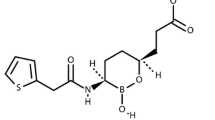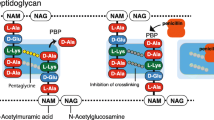Abstract
Extended-spectrum beta-lactamases (ESBLs) have now been described in many hospitals worldwide. While they have been detected in many pathogenic gram-negative bacteria, they are particularly prevalent inKlebsiella isolates. Known risk factors for colonization and/or infection with organisms harboring these enzymes include admission to an intensive care unit, recent surgery, instrumentation, prolonged hospital stay and antibiotic exposure, especially exposure to extended-spectrum beta-lactam agents. In this report three recent epidemics from the USA will be described in which the role of selective antibiotic pressure seems clear. Data from two hospital epidemics, one from New York and another from Stanford, California, will be reviewed briefly. In addition, recent studies describing the spread of extended-spectrum beta-lactamases among nursing home patients in Chicago, Illinois, will be outlined. The limited data available on treatment options for patients infected with ESBL-containing strains will be reviewed, focusing on the activity of piperacillin/tazobactam and imipenem against these otherwise broadly resistant strains. Lastly, attempts to control these organisms, including infection control measures and selective bowel decontamination, will be reviewed.
Similar content being viewed by others
References
Knothe H, Shah P, Kremery V, Anatal M, Mitsuhashi S: Transferable resistance to cefotaxime, cefoxitin, cefamandole and cefuroxime in clinical isolates ofKlebsiella pneumoniae andSerratia marcescens. Infection 1983, 11: 315–317.
Sirot D, Sirot J, Labia R, Morand A, Courvalin P, Darfcuille-Michaud A, Perroux R, Cluzel R: Transferable resistance to third generation cephalosporins in clinical isolates ofKlebsiella pneumoniae: identification of CTX-1, a novel beta-lactamase. Journal of Antimicrobial Chemotherapy 1987, 20: 323–334.
Brun-Buisson C, Legrand P, Philippon A, Montravers F, Ansquer M, Dura J: Transferable enzymatic resistance to third-generation cephalcsporins during nosocomial outbreak of multi-resistantKlebsiella pneumoniae. Lancet 1987, ii: 302–306.
Sirot J, Chanal G, Petit A, Sirot D, Labia R, Gerband G:Klebsiella pneumoniae and otherEnterobacteriaceae producing novel plasmid-mediated beta-lactamases markedly active against third-generation cephalosporins: epidemiologic studies. Reviews of Infectious Diseases 1988, 10: 850–859.
Jarlier V, Nicholas MH, Fournier G, Philippon A: Extended broad-spectrum beta-lactamases conferring transferable resistance to newer beta-lactam agents inEnterobacteriaceae: hospital prevalence and susceptibility pattems. Reviews of Infectious Diseases 1988, 10: 867–878.
DeChamps C, Sauvant MP, Chanal C, Sirot D, Gazuy N, Malhuret R: Prospective survey of colonization and infection caused by expanded-spectrum familyEnterobacteriaceae in an intensive care unit. Journal of Clinical Microbiology 1989, 7: 2887–2890.
Quinn JP, Miyashiro D, Sahm D, Flamm R, Bush K: Novel plasmid-mediated beta-lactamase (TEM-10) conferring selective resistance to ceftazidime and aztreonam in clinical isolates ofKlebsiella pneumoniae. Antimicrobial Agents and Chemotherapy 1989, 33: 1451–1456.
Jacoby GA, Medeiros AA, O'Brien TF, Pinto ME, Jiang J: Broad-spectrum transmissible β-lactamases. New England Journal of Medicine 1989, 319: 723.
Philippon A, Labia R, Jacoby GA: Extended-spectrum β-lactamases. Antimicrobial Agents and Chemotherapy 1989, 3: 1131–1136.
Jacoby FA, Medeiros AA: More extended-spectrum beta-lactamases. Antimicrobial Agents and Chemotherapy 1991, 35: 1697–1704.
Sirot DL, Goldstein FW, Soussy CJ, Courtieu AL, Husson MD, Lemozy J, Meyran M, Morel C, Perez R, Quentin-Noury G, Reverdy ME, Scheftel JM, Rosembaum M, Rezvani Y: Resistance to cefotaxime and seven other beta-lactams in members of the familyEnterobacteriaceae: a 3-year survey in France. Antimicrobial Agents and Chemotherapy 1992, 36: 1677–1681.
Liu PY, Gur D, Hall LM, Livermore DM: Survey of the prevalence of beta-lactamases amongst 1000 gramnegative bacilli isolated consecutively at the Royal London Hospital. Journal of Antimicrobial. Chemotherapy 1992, 30: 429–447.
Rice LB, Willey SH, Papanicolaou GA, Medeiros AA, Eliopoulos GM, Moellering RC Jr, Jacoby G: Outbreak of ceftazidime resistance caused by extended-spectrum beta-lactamases at a Massachusetts chronic-care facility. Antimicrobial Agents and Chemotherapy 1990, 4: 219–239.
Naumovski L, Quinn JP, Miyashiro D, Patel M, Bush K, Singer SB, Graves D, Palzkill T, Arvin AM: Out-break of ceftazidime resistance due to a novel extended-pectrum beta-lactamase in isolates from cancer patients. Antimicrobial Agents and Chemotherapy 1992, 36: 1991–1996.
Meyer KS, Urban C, Egan JA, Berger BJ, Rahal JJ: Nosocomial outbreak ofKlebsiella infection resistant to late-generation cephalosporins. Annals of Internal Medicine 1993, 119: 353–358.
Papanicolaou GA, Medeiros AA, Jacoby GA: Novel plasmid-mediated beta-lactamase (MIR-1) conferring resistance to oxymino- and alpha-methoxy beta-lactams in clinical isolates ofKlebsiella pneumoniae. Antimicrobial Agents and Chemotherapy 1990, 34: 2200–2209.
Rasmussen BA, Bradford PA, Quinn JP, Wiener J, Weinstein RA, Bush K: Genetically diverse ceftazidime-resistant isolates from a single center: biochemical and genetic characterization of TEM-10 β-lactamases encoded by different nucleotide sequences. Antimicrobial Agents and Chemotherapy 1993, 37: 1989–1992.
Rice LB, Yao JD, Klimm K, Eliopoulos, GM, Moellering RC Jr: Efficacy of different beta-lactams against an extended-spectrum beta-lactamase-producingKlebsiella pneumoniae strain in the rat intra-abdominal abscess model. Antimicrobial Agents and Chemotherapy 1991, 35: 1243–1244.
Mentec H, Vallois JM, Bure A, Saleh-Mghir A, Jehl F, Carbon C: Piperacillin, tazobactam, and gentamycin alone or combined in an endocarditis model of infection by a TEM-3 producing strain ofKlebsiella pneumoniae or its susceptible variant. Antimicrobial Agents and Chemotherapy 1992, 36: 1883–1889.
Urban C, Go E, Mariano N, Berger BJ, Avraham I, Rubin D, Rachel J: Effect of sulbactam on infections caused by imipenem-resistantAcinetobacter calcoaceticus biotypeantitratus. Journal of Infectious Diseases 1993, 167: 448–451.
Brun-Buisson C, Legrand P, Rauss A, Richard C, Montravers F, Besbes M, Meakins J, Soussy CJ, Lemaire F: Intestinal decontamination for control of nosocomial multi-resistant gram-negative bacilli. Annals of Internal Medicine 1989, 110: 873–881.
Baquero F, Canton R, Martinez-Beltran J, Bolstrom A: The E-test as an epidemiologic tool. Diagnostic Microbiology and Infectious Disease 1992, 15: 483–487.
Author information
Authors and Affiliations
Rights and permissions
About this article
Cite this article
Quinn, J.P. Clinical significance of extended-spectrum beta-lactamases. Eur. J. Clin. Microbiol. Infect. Dis. 13 (Suppl 1), S39–S42 (1994). https://doi.org/10.1007/BF02390683
Issue Date:
DOI: https://doi.org/10.1007/BF02390683




